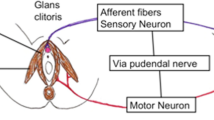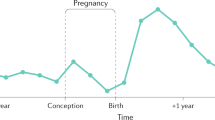Abstract
Purpose To evaluate the safety and efficacy of injections with botulinum toxin type A (BTTA, Botox®), given transcutaneously, in the treatment of upper lid retraction associated with thyroid eye disease (TED).
Methods A total of 15 patients (21 eyes) with a stable (TED) condition, and a euthyroid state, were enrolled into the study. There were 12 females and three males from ages 23 to 52 years. A single injection, at the centrally superior tarsal border transcutaneously, aiming at the levator aponeurosis and Müller muscle, was administered into each eyelid with 5–6 U of Botox®. All patients were followed regularly for 4–6 months. Any complications, such as ptosis, diplopia, pain, or lid ecchymosis were recorded.
Results All patients, except one, experienced much reduction of palpebral fissure. The mean difference of MRD1 between pre- and postinjections of Botox® at the first week was −3.1 mm, and the effect remained, at least, for 2 months. There were temporary complications of ptosis in three patients and vertical diplopia in two patients, lasting 3–4 weeks.
Conclusions A single transcutaneous injection with Botox® for the treatment of thyroid lid retraction is safe and effective. Some minor complications may occur, such as ptosis and diplopia; however, it may offer an alternative and temporary method for patients with dysthyroid lid retraction, who are waiting for a staged operation of either an orbital decompression or a strabismus surgery or both.
Similar content being viewed by others
Introduction
The clinical characteristics of thyroid eye disease (TED) include soft-tissue swelling, lid retraction, proptosis, restrictive myopathy, and compressive optic neuropathy. Among these manifestations, eyelid retraction in TED is the most common sign, where 25–50% of thyroid disease patients may have ocular complications. Of this group, 90% of these patients may have lid retraction at some point during their clinical course.1 The mainstay for the management of upper lid retraction in TED is either by observation or surgical techniques. This depends on the severity of corneal involvement. Surgery by recession of the levator aponeurosis, Müller muscle or both2 or Müllerectomy should be postponed for 6–12 months until the disease activity is stabilized. Another surgical deliberation is the management of lid retraction, where it should be deferred by an orbital decompression or a strabismus surgery.3Patients with an extreme degree of thyroid lid retraction may suffer from keratitis during this long period of exposure. Some nonsurgical alternatives to treat thyroid lid retraction have been postulated, such as, guanethidine, a topical adrenergic blocker.4 These postulations were abandoned owing to the intolerable side effects. Chang et al5 and Kung et al6 reported the effects in the treatment of TED using somatostatin or prednisolone; however, the height of palpebral aperture did not dramatically decrease. Scott7 first demonstrated the use of botulinum toxin type A (BTTA) for the treatment of thyroid lid retraction. This conjecture derives from the management of strabismus and blepharospasm, which is relevant to a possible ptosis complication.8Some authors9,10reported the successful induction of nearly complete ptosis in patients with indolent corneal ulceration; however, a major side effect of weakness in the superior rectus muscle was noted. Several reports11,12,13,14 illustrated the effects of injections with BTTA in thyroid lid retraction; nevertheless, there were some variations between them, including the method of dispensation, optimal dosage, and rate of complications. We present our results of treatment with BTTA injections for thyroid lid retraction and compare the outcome with the previous literature.
Materials and methods
From February 2002 through January 2003, a total of 15 patients (21 eyes: 12 bilateral and nine unilateral) with thyroid lid retraction, who were confirmed to be in a stable TED state, were objectively evaluated using a marginal reflex distance (MRD), exophthalmometry, and given a clinical activity score (CAS).3 The patients, who were enrolled into this study, were also evaluated to be in a euthyroid state for, at least, 6 months by T3, T4 and TSH serological testing. There were 12 female and three male, patients, whose ages were from 23 to 52 years. We objectively measured the degree of upper lid retraction by documenting the distance from the corneal light reflex to the upper lid margin (MRD1) in the primary position. The extraocular movement was also checked before and after injections of BTTA. All the patients were informed about the benefits and possible side effects of injection with BTTA (Botox, Allergan, Inc., Irvine, CA, USA). Informed consent was obtained.
We reconstituted the Botox® solution using 1 cm3 unpreserved normal saline, yielding a concentration solution of 1 U/0.01 cm3. Using a 0.3 or 0.5 cm3. commercially manufactured insulin syringe, a single transcutaneous injection at the centrally superior tarsal border, aiming at the complex of levator aponeurosis and Müller muscle under the protection using an eye shield, was administered into each eyelid with 5–6 U (0.05–0.06 cm3, 5–6 U as shown in the scale of the insulin syringe) (Figure 1). There was no supplement of local anaesthesia. After injections of Botox®, all the patients were regularly followed up from 4 to 6 months. Any side effects, including ptosis, diplopia, pain, ecchymosis, or ocular discomfort, were recorded.
Results
Most patients, except one, experienced much improvement of the upper eyelid retraction (Figure 2). The mean difference of MRD1 between pre- and postinjection of Botox® at the first week was –3.1 mm (range, 0 to −8 mm) after a single dose injection (Table 1). An additional 4 U (0.04 cm3) of Botox® was administered to the eyelid with a meagre response a week after, and the patient was satisfied with the end result (Table 1, patient 10, left eye). All the patients achieved maximal improvement of lid retraction within 1 week, which remained at least for 8 weeks. There were three patients with complications of ptosis, one complete and two incomplete; nonetheless, these disappeared spontaneously within 1 month (Figure 3). Two patients suffered from transient vertical diplopia for 20 days after the injection of Botox®. We noted that there are some variations of response to Botox® injection in patients with a similar degree of lid retraction. There were no patients complaining of pain or lid ecchymosis after injection. After a regular monthly follow-up, all the patients recovered to the pretreated level of lid retraction before the fifth month postinjection of Botox®.
The same patient suffered from an incomplete ptosis in the left eye noted at the first follow-up postinjection of Botox®; however, the condition resolved completely and spontaneously, shown in Figure 2b, within 1 month.
Discussion
We report the effects of Botox® injection transcutaneously with a single dose for patients with dysthyroid lid retraction, who remained in a stable ophthalmic condition and a systemically euthyroid state. There were fewer complications of ptosis and vertical diplopia in this study compared to those in other studies.11,12,13,14 Details are shown in Table 2. From previous studies, we noted more patients with complications of ptosis or vertical diplopia with injections of Botox® underneath the superior orbital rim, which is anatomically located near the levator palpebrae superioris, and the common sheath of the levator palpebrae superioris and the superior rectus muscle. To avoid these complications from occurring, it is suggested that the site of injection should be in close proximity to the insertion of the levator aponeurosis and Müller muscle.
Although the response of patients with thyroid lid retraction to Botox® injection varies, we believe that a single dose of 5 U of Botox® solution is enough for most patients with a moderate-to-severe degree of lid retraction. Several repeated injections of Botox® in meagre response of patients, in previous reports, may contribute to the site of injection rather superficially. Either transcutaneous or subconjunctival injection14 of Botox® can be performed; however, we deem that the eversion of the upper eyelid may produce more discomfort for patients. As ophthalmopathy can be aggravated by an unstable thyroid state, prevention or correction of both hyper- and hypothyroidism is essential. This is the reason for our choice of patients with lid retraction in a euthyroid state instead of patients in a systemically acute inflammatory stage. Similarly, we also did not include patients with an unstable ophthalmic condition because during the clinical course of TED, fluctuation of disease activity is more common in an acute stage. Premature injection of Botox® may result in more arbitrary results, and a spontaneous resolution in lid retraction may also be masked by the injection of Botox®. The possible mechanism of thyroid lid retraction is a combination of early inflammatory and late fibrotic factors. We do not think that there is any permanent effect with the administration of Botox® to a thyroid lid retraction, at an ophthalmically acute inflammatory stage, because it does not change the environment of inflammation.
The effects of Botox® are temporary and the duration is about 2–4 months, as we learn in our study. Although the pharmacological mechanism of Botox® is the inhibition of the presynaptic release of acetylcholine at the neuromuscular junction, we found that there is still a response upon injection of Botox® to the levator aponeurosis, but not to the muscle itself. This may produce an optimal palpebral height with no obvious complication of ptosis.
Conventionally, patients with thyroid lid retraction require a waiting period before lid surgery correction. This waiting period may include either an orbital decompression or a strabismus surgery, or both. Therefore, there is a long period of time for them with a disfiguring lid appearance. Although there are various responses between inter- or intra-patients after injection, it may offer an alternate method for patients during a staged operation because the administration of Botox® to thyroid lid retraction is rather safe and effective with little complication.
References
Bartley GB, Fatourechi V, Kadrmas EF, Jacobsen SJ, Ilstrup DM, Garrity JA et al. Clinical features of Graves'ophthalmopathy in an incidence cohort. Am J Ophthalmol 1996; 121: 284–290.
Ceisler EJ, Bilyk JR, Rubin PA, Burks WR, Shore JW . Results of Müllerotomy and levator aponeurosis transposition for the correction of upper eyelid retraction in Graves' disease. Ophthalmology 1995; 102: 483–492.
Bartalena L, Pinchera A, Marcocci C . Management of Graves'ophthalmopathy: reality and perspectives. Endocr Rev 2000; 21(2): 168–199.
Cant JS, Lewis DR, Harrison MT . Treatment of dysthyroid ophthalmopathy with local guanethidine. Br J Ophthalmol 1969; 53: 233–238.
Chang TC, Kao SCS, Huang KM . Octreotide and Graves' ophthalmopathy and pretibial myxoedema. BMJ 1992; 304: 158.
Kung WC, Michon J, Tai KS, Chan FL . The effect of somatostatin versus corticosteroid in the treatment of Graves' ophthalmopathy. Thyroid 1996; 6(5): 381–384.
Scott AB . Injection treatment of endocrine orbital myopathy. Doc Ophthalmol 1984; 58: 141–145.
Elston JS, Lee JP, Hogg PC, Clark P . Treatment of strabismus in adults with botulinum toxin A. Br J Ophthalmol 1985; 69: 718–724.
Adams GG, Kirkness CM, Lee JP . Botulinum toxin A induced protective ptosis. Eye 1987; 1: 603–608.
Kirkness CM, Adams GG, Dilly PN, Lee JP . Botulinum toxin A-induced protective ptosis in corneal disease. Ophthalmology 1988; 95: 473–480.
Ebner R . Botulinum toxin type A in upper lid retraction of Graves' ophthalmopathy. J Clin Neuro-ophthalmol 1993; 13: 258–261.
Biglan AW . Control of eyelid retraction associated with Graves' disease with botulinum A toxin. Ophthalmic Surg 1994; 25: 186–188.
Ozkan SB, Can D, Soylev MF, Arsan AK, Duman S . Chemodenervation in treatment of upper eyelid retraction. Ophthalmologica 1997; 211: 387–390.
Uddin JM, Davies PD . Treatment of upper eyelid retraction associated with thyroid eye disease with subconjunctival botulinum toxin injection. Ophthalmology 2002; 109: 1183–1187.
Author information
Authors and Affiliations
Corresponding author
Rights and permissions
About this article
Cite this article
Shih, MJ., Liao, SL. & Lu, HY. A single transcutaneous injection with Botox® for dysthyroid lid retraction. Eye 18, 466–469 (2004). https://doi.org/10.1038/sj.eye.6700690
Received:
Accepted:
Published:
Issue Date:
DOI: https://doi.org/10.1038/sj.eye.6700690
Keywords
This article is cited by
-
Optimizing esthetic outcomes in graded full-thickness anterior blepharotomy for Graves’ ophthalmopathy
Graefe's Archive for Clinical and Experimental Ophthalmology (2019)
-
Comment on ‘Acute thyroid eye disease (TED): Principles of medical and surgical management’
Eye (2014)
-
Response to Drs Litwin and Malhotra
Eye (2014)
-
Injection of transcutaneous botulinum toxin as a temporary treatment option for congenital eyelid retraction
European Journal of Plastic Surgery (2012)
-
Comparative study of Botox® injection treatment for upper eyelid retraction with 6-month follow-up in patients with thyroid eye disease in the congestive or fibrotic stage
Eye (2009)






